1. Watch these videos
1. a. Natural Selection: What Every AP Bio Student Needs to Know
1.b. Natural Selection Song: The Ballad of the Peppered Moth
2. Study this summary
Overview
The philosopher Daniel Dennett was famously quoted as saying that natural selection is “the best idea anybody ever had, ahead of Newton, ahead of Einstein.” In this video, we examine how natural selection (along with artificial selection and sexual selection) shapes organisms’ phenotypes.
Individuals are selected: populations evolve: Note that all of the types of selection explained below happen at the population level. Individual organisms are selected by the environment (or breeders) for survival and reproduction. Through repeated rounds of selection, populations become more adapted over time.
Artificial Selection
- Definition: Also known as selective breeding, it involves humans selecting organisms with desired traits to breed over generations.
- Examples:
- Brassica oleracea: A single species selectively bred into varieties like cauliflower (for flower clusters), broccoli (for flower buds), and Brussels sprouts (for lateral buds).
- Dogs: Breeds like German Shepherds and Dachshunds are all derived from wolves (Canis lupus), bred for traits like hunting, protection, or appearance.
Natural Selection
- How Natural Selection Works
- Inherited (genetic) variation exists in populations, driven by recombination and mutation.
- More individuals are born than can survive (“many are born, but few survive”). One of the main reasons why few offspring survive is competition for limited resources
- Survivors have beneficial traits that provide an advantage.
- Mutations introduce new variations over generations.
- Repeating steps 1 through 4 leads to adaptations.
- A few types of adaptations, with examples:
- Structural: Bat wings for flight.
- Behavioral: Sonar in bats for navigation.
- Camouflage: The satanic leaf gecko blending with its environment.
- Molecular: Enzyme-substrate specificity.
Sexual Selection
- Definition: Selection for traits that directly enhance reproductive success, often leading to sexual dimorphism (differences between male and female phenotypes).
- Types:
- Intersexual Selection:
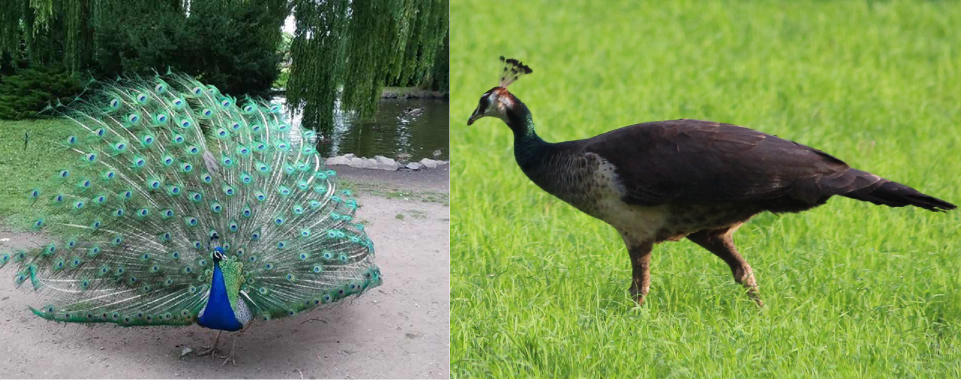
Left: A male peacock’s train of feathers can be explained through intersexual selection. Right: A peahen (female) - Females choose males based on traits like elaborate displays or features.
- Examples: Elaborate coloration in a male peacock’s feathers, or the courtship displays of many birds.
- Intrasexual Selection:
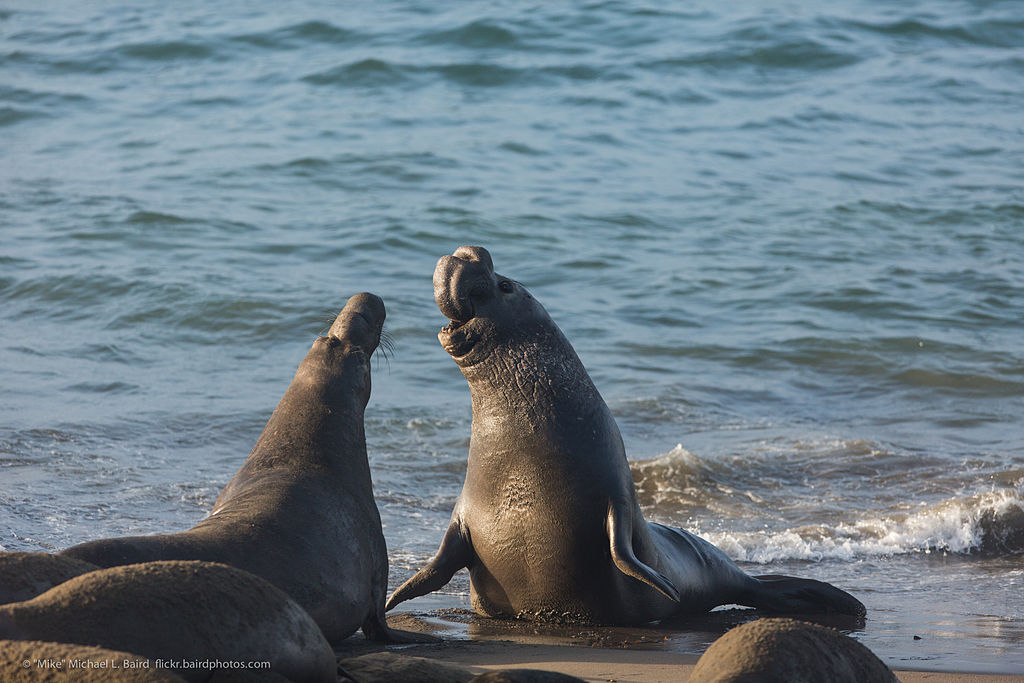
Two male elephant seals. The difference in size between male and female elephant seals can be explained through intrasexual selection - Males compete for control of a harem of females, or for breeding territories.
- Example: Elephant seals; males are twice the size of females and highly aggressive.
- Intersexual Selection:
Types of Natural Selection
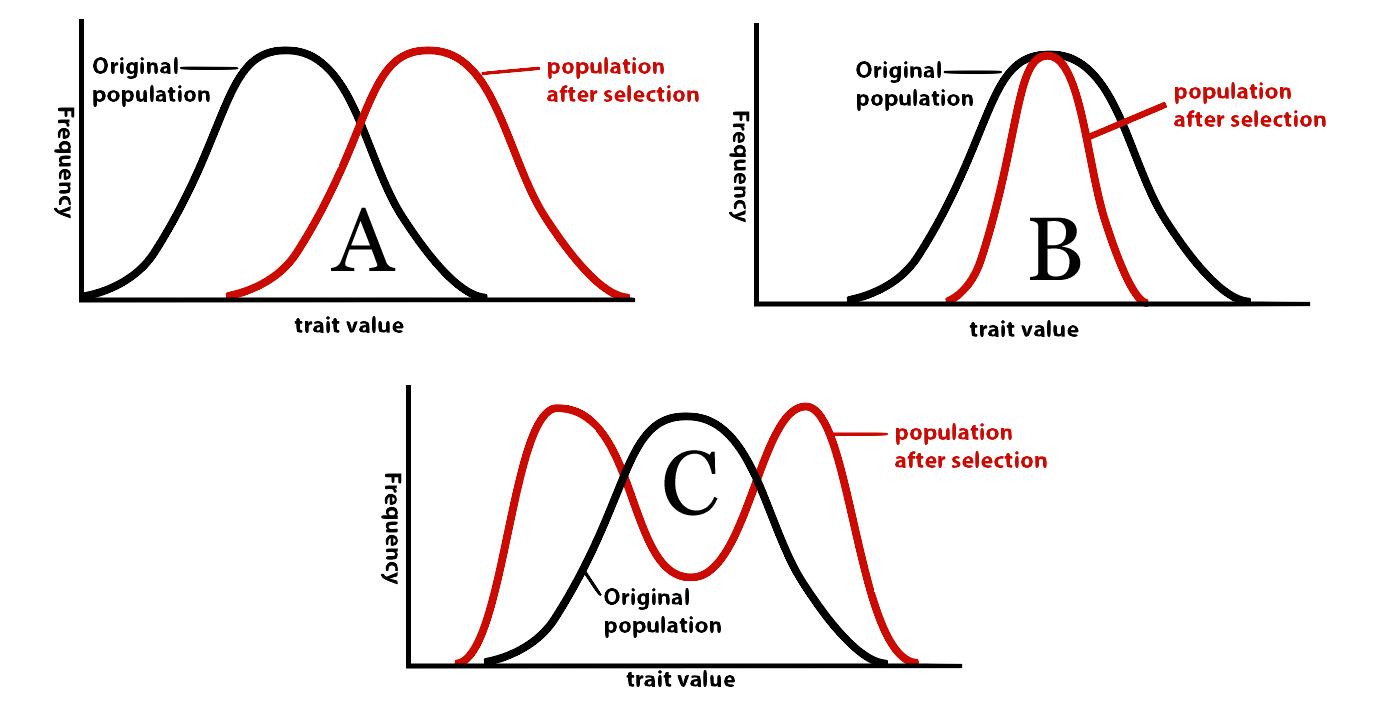
- Directional Selection:
- Selects against one extreme, shifting the population’s phenotype in one direction.
- Example: Adaptive melanism in the rock pocket mouse, where dark-colored mice became prevalent in dark-colored environments.
- Stabilizing Selection:
- Selects against both extremes, favoring the average phenotype.
- Example: Human birth weight; average-sized babies have higher survival rates.
- Disruptive Selection:
- Selects against the average phenotype, favoring both extremes, potentially splitting the population.
Evolutionary Fitness
- Definition: Measured by the number of surviving offspring and their descendants that reproduce.
- Key Idea: Fitness is about reproductive success, not physical strength or speed.
Illustrative Example: Peppered Moth
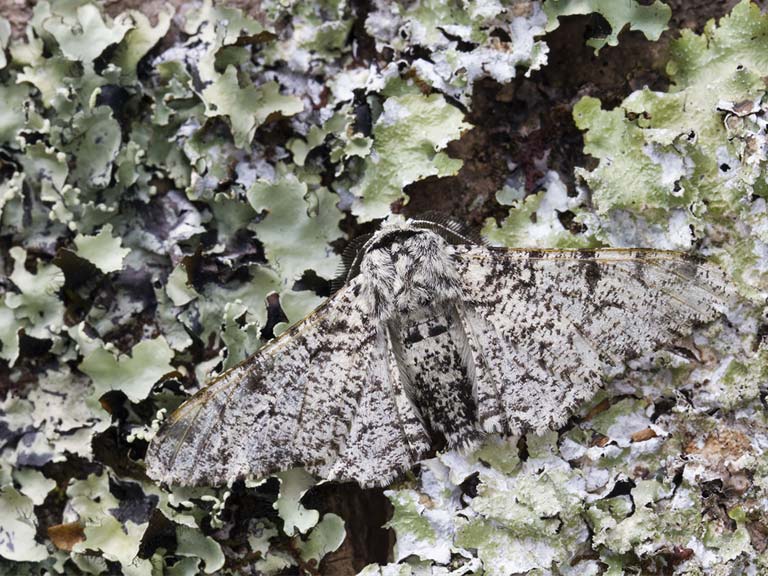
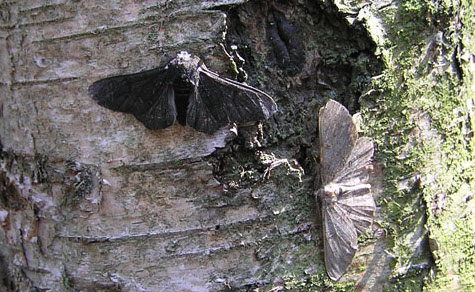
- Significance: A directly observed example of directional selection and adaptive melanism.
- History
- Before the Industrial Revolution (early 1800s): Light-colored moths were predominant due to camouflage on lichen-covered trees.
- During the Industrial Revolution: Soot darkened tree trunks. In the next few decades, dark-colored moth became the predominant phenotype.
- 1960s: Clean Air Acts and pollution reduction in the late 20th century lightened tree trunks, shifting the phenotype back to predominantly light-colored moths.
3. Master these flashcards
[qdeck style=”width: 600px !important; min-height: 450px !important;” bold_text=”false” qrecord_id=”sciencemusicvideosMeister1961-Natural, Artificial, and Sexual Selection, APBVP”]
[h]Artificial, Natural, and Sexual Selection
[i]
[q] Through artificial selection, breeders have created hundreds of varieties of plants and animals suited to human purposes. Explain how artificial selection works.
[a] In artificial selection (or selective breeding), animal or plant breeders envision a desired trait in an animal or a plant. For many generations, breeders select individuals with that desired trait, allowing only those with the desired trait to reproduce.
In plant breeding, breeders select seeds from plants with the desired traits and use those seeds to sow the next crop. In the case of animals, breeders select males and females with the desired traits and breed them together.
[q]Define natural selection, and in five steps, explain how natural selection works.
[a]Natural selection is the differential survival and reproduction of individuals of the same species due to differences in phenotype.
- In every population, there’s inherited variation.
- In every species, parents produce offspring at a rate that exceeds that environment’s ability to support them. In other words, many are born but few survive.
- The ones who survive will most often be those with beneficial traits.
- Ongoing mutation renews variation
- The process gets repeated generation after generation.
[q] What’s the relationship between individual organisms, selection, and evolution?
[a] Individual organisms are selected by the environment for survival and reproduction. Through repeated rounds of selection, populations become more adapted over time. Individuals are selected: populations evolve.
[q] From an evolutionary perspective, what is fitness?
[a] Fitness is a measure of the number of offspring that survive to reproduce.
[q] Why is mutation important to evolution?
[a] Mutation provides the variation upon which natural selection acts. Because of mutation, natural selection can be a creative force that shapes new adaptations (as opposed to a process that merely culls unfavorable phenotypes from a population).
[q]Compare and contrast natural selection and sexual selection.
[a]Natural selection is the differential survival and reproduction of individuals of the same species due to differences in phenotype. Sexual selection can be thought of as a subcategory of natural selection: it’s the advantage that some members of one sex have over other individuals of the same sex solely in relation to reproduction.
[q]How does intersexual selection differ from intrasexual selection, and what kind of phenotypes does each one produce?
[a]In intersexual selection, one sex (often females) chooses mates of the other sex, selecting phenotypes that they find more attractive. Intersexual selection leads to males that are highly adorned, with bright colors or other features that can attract a female’s attention.
In intrasexual selection, members of one sex (typically males) compete with one another to control reproductive access to females, either through controlling a territory (e.g. elephant seals) or controlling a harem (e.g. gorillas, certain species of deer). Intrasexual selection selects for size, strength, and weaponry, and leads males who are large and aggressive (compared to females) and often have weapons such as horns or antlers that are used in male-against-male competition.
[q]Give examples of artificial selection.
[a]1. Brassica oleracea: Bred into varieties like cauliflower, broccoli, and Brussels sprouts.
2. Dogs: Breeds like German Shepherds and Dachshunds, derived from wolves and bred for traits like hunting or appearance.
[q]What are examples of adaptations from natural selection?
[a]1. Structural: Bat wings for flight.
2. Behavioral: Sonar in bats for navigation.
3. Camouflage: The satanic leaf gecko blending into its environment.
4. Molecular: Enzyme-substrate specificity.
[q]What is directional selection? Give one example
[a]Selection against one extreme, shifting the population’s phenotype in one direction. Example: Adaptive melanism in the rock pocket mouse: Dark-colored mice became prevalent in dark-colored environments.
[q]What is stabilizing selection? Give one example
[a]Selection against both extremes, favoring the average phenotype. Example: Human birth weight: Average-sized babies have higher survival rates compared to very small or very large babies.
[q]What is disruptive selection?
[a]Selection against the average phenotype, favoring both extremes, which may split the population.
[q]What happened to the peppered moth during the Industrial Revolution? Why is the peppered moth important?
[a]1. Before: Light-colored moths were camouflaged on lichen-covered trees.
2. During: Soot darkened tree trunks, favoring dark-colored moths (adaptive melanism).
3. After: Clean Air Acts lightened tree trunks, shifting phenotypes back to light-colored moths.
Importance: It’s a historically documented example of directional selection and adaptive melanism in response to environmental change.
[/qdeck]
4. Tackle these quizzes
4.1. Adaptation and Selective Breeding
[qwiz qrecord_id=”sciencemusicvideosMeister1961-Adaptation and Selective Breeding, APBVP”]
[h]Adaptation and Selective Breeding
[i]Biohaiku
Selective breeding:
Humans choose traits they desire
Wolves became poodles
[q] A trait that can help an organism survive and/or reproduce is called a(n) [hangman]
[c]IGFkYXB0YXRpb24=[Qq]
[q] In the case of the leaf insect, the adaptation is for [hangman].
[c]IGNhbW91ZmxhZ2U=[Qq]
[q] For a trait to be adaptive, it must help an organism to [hangman] or reproduce.
[c]IHN1cnZpdmU=[Qq]
[q]In domesticated plants and animals, humans produce desired traits through the process of [hangman] breeding
[c]c2VsZWN0aXZl[Qq]
[q]For selective breeding to work, a breeder must select (or breed for) the same trait for multiple [hangman]
[c]Z2VuZXJhdGlvbnM=[Qq]
[q]Terriers, poodles, labrador retrievers, and chihuahuas are all members of the same [hangman]. Their differences were brought about through [hangman] breeding, also known as [hangman] selection.
[c]c3BlY2llcw==[Qq]
[c]c2VsZWN0aXZl[Qq]
[c]YXJ0aWZpY2lhbA==[Qq]
[q]In animals like dogs, breeders have been able to create breeds with specific body forms and specific [hangman], such as protecting, retrieving, herding,
[c]YmVoYXZpb3Jz[Qq]
[/qwiz]
4.2 Adaptation, Artificial Selection, and Natural Selection
[qwiz qrecord_id=”sciencemusicvideosMeister1961-Adaptation, Artificial Selection, and Natural Selection, APBVP”]
[h] Adaptation, Artificial Selection, and Natural Selection
[i]Biohaiku (inspired by Darwin)
Selective pressure
Wedges pound down; many die
The fittest survive
[q] Kale, broccoli, and cauliflower are all [hangman]that were bred from the wild cabbage, Brassica oleracea.
[c]IHZhcmlldGllcw==[Qq]
[f]IEdyZWF0IQ==[Qq]
[q] During the creation of any particular dog breed, breeders selected males and females with [hangman] phenotypes, and bred them together. The breed emerged after breeders repeated this process for many [hangman]
[c]IGRlc2lyZWQ=[Qq]
[f]IEdyZWF0IQ==[Qq]
[c]IGdlbmVyYXRpb25z[Qq]
[f]IEdyZWF0IQ==[Qq]
[q multiple_choice=”true”] Adaptations arise through
[c]IGFydGlmaWNpYWwgc2VsZWN0aW9u[Qq]
[f]IE5vLiBBcnRpZmljaWFsIHNlbGVjdGlvbiBpcyBob3cgaHVtYW5zIGJyaW5nIGFib3V0IGRlc2lyZWQgdHJhaXRzIGluIGRvbWVzdGljYXRlZCBwbGFudCBvciBhbmltYWwgc3BlY2llcy4gSGVyZSYjODIxNztzIGEgaGludDogYWRhcHRhdGlvbnMgY29tZSBhYm91dCB3aXRob3V0IGh1bWFuIGRlc2lnbi4gV2hhdCBwcm9jZXNzIGNvdWxkIGJyaW5nIHRoYXQgYWJvdXQ/[Qq]
[c]IE5hdHVyYWwg c2VsZWN0aW9u[Qq]
[f]IEV4Y2VsbGVudC4gQWRhcHRhdGlvbnMgYXJpc2UgdGhyb3VnaCBuYXR1cmFsIHNlbGVjdGlvbi4=[Qq]
[c]IG11dGF0aW9u[Qq]
[f]IE5vLiBNdXRhdGlvbiBpcyBhIHBhcnQgb2YgaG93IG5hdHVyZSBjcmVhdGVzIGFkYXB0YXRpb25zLCBidXQgb25seSBhIHBhcnQuIFdoYXQmIzgyMTc7cyB0aGUgbmFtZSBvZiB0aGUgZW50aXJlIHByb2Nlc3M/[Qq]
[q multiple_choice=”true”] The kind of variation that matters most for natural selection is
[c]IHZhcmlhdGlvbnMgaW5kdWNlZCBieSBlbnZpcm9ubWVudGFsIGZhY3RvcnM=[Qq]
[f]IE5vLiBUaGUgZW52aXJvbm1lbnQgY2FuIGluZmx1ZW5jZSB0aGUgcGhlbm90eXBlIG9mIGFuIG9yZ2FuaXNtLiBCdXQgdGhvc2UgY2hhbmdlcyBnZW5lcmFsbHkgY2FuJiM4MjE3O3QgZ2V0IHBhc3NlZCBvbiB0byB0aGUgbmV4dCBnZW5lcmF0aW9uLg==[Qq]
[c]IGxlYXJuZWQgYmVoYXZpb3Jz[Qq]
[f]IE5vLiBMZWFybmluZyBjYW4gYmUgb2Ygc3Vydml2YWwgdmFsdWUsIGJ1dCBub3QgaW4gYSB3YXkgdGhhdCBjYW4gYmUgZGlyZWN0bHkgYWN0ZWQgdXBvbiBieSBuYXR1cmFsIHNlbGVjdGlvbi4=[Qq]
[c]IGdlbmV0aWMg dmFyaWF0aW9u[Qq]
[f]IE5pY2UuIEdlbmV0aWMgdmFyaWF0aW9uIGlzIHRoZSB0eXBlIHRoYXQgbWF0dGVycyBtb3N0IGZvciBuYXR1cmFsIHNlbGVjdGlvbi4=[Qq]
[q]A fact about nature is that when organisms reproduce, there’s always over[hangman] of offspring. In other words, parents produce many more offspring than can [hangman].
[c]cHJvZHVjdGlvbg==[Qq]
[c]c3Vydml2ZQ==[Qq]
[q]One of the main reasons why few offspring survive is [hangman] for limited [hangman].
[c]Y29tcGV0aXRpb24=[Qq]
[c]cmVzb3VyY2Vz[Qq]
[q]Competition for limited resources leads to differential survival. Not only will few survive, but there will be differences among the survivors. Any offspring with a phenotype that gives it a(n) [hangman] will be more likely to survive to adulthood and reproduce.
[c]YWR2YW50YWdl[Qq]
[q]One ironic result of natural selection is that predators produce prey that are more difficult to [hangman] upon. They do this by killing all of the prey that are [hangman] to catch. In the case of the peppered moth, the survivors will be those with the best [hangman].
[c]cHJleQ==[Qq]
[c]ZWFzeQ==[Qq]
[c]Y2Ftb3VmbGFnZQ==[Qq]
[q]The dynamic that unfolds between predator and prey, or between individuals that are competing for the same resource is an evolutionary arms race. Every adaptation in the predator leads to a counter [hangman] in the prey, which feeds back to the predator in the next generation.
[c]YWRhcHRhdGlvbg==[Qq]
[q]Fill in the blanks for this summary of natural selection.
In every population, there’s [hangman]. The type that matters for natural selection is caused by [hangman].
In every species, parents produce [hangman] at a rate that exceeds that environment’s ability to support them. In other words, many are [hangman], but few [hangman].
Overproduction of offspring leads to differential survival.
The ones who survive will most often be those with [hangman] traits.
[hangman] of this process for many generations leads to [hangman]
[c]dmFyaWF0aW9u[Qq]
[c]aGVyZWRpdHk=[Qq]
[c]b2Zmc3ByaW5n[Qq]
[c]Ym9ybg==[Qq]
[c]c3Vydml2ZQ==[Qq]
[c]YmVuZWZpY2lhbA==[Qq]
[c]cmVwZXRpdGlvbg==[Qq]
[c]YWRhcHRhdGlvbg==[Qq]
[q]Variation in a population is maintained by ongoing [hangman] of the genes with a population’s gene pool.
[c]bXV0YXRpb24=[Qq]
[q]Individuals don’t [hangman]. Rather, individuals are [hangman]. The thing that evolves is the [hangman].
[c]IGV2b2x2ZQ==[Qq]
[c]IHNlbGVjdGVk[Qq]
[c]IHBvcHVsYXRpb24=[Qq]
[q]Natural selection is often summarized as [hangman] of the [hangman]. That last term means the individuals who have the most [hangman] success.
[c]c3Vydml2YWw=[Qq]
[c]Zml0dGVzdA==[Qq]
[c]cmVwcm9kdWN0aXZl[Qq]
[q json=”true” multiple_choice=”true” unit=”7.Evolution” topic=”7.1-7.3.Natural_and_Artificial_Selection” dataset_id=”Unit 7 Cumulative MC Dataset|20ee4c86308aeb” question_number=”1″] The Galapagos Flightless Cormorant (Phalacrocorax harrisi) is the world’s only flightless cormorant. It has short, vestigial wings, and it’s heavier than any other cormorant species. It’s found only on the islands of Fernandina and Isabela.
DNA evidence indicates that the Galapagos Flightless Cormorant is closely related to the Neotropic Cormorant (Nannopterum brasilianum). The Neotropic Cormorant is a strong flyer that, like all cormorants, preys on fish.
Which of the following is the best explanation for the flightlessness of the Galapagos cormorant?
[c]IEJlY2F1c2UgdGhlIEdhbGFwYWdvcyBGbGlnaHRsZXNzIENvcm1vcmFudCBsaXZlcyBvbiBsYW5kIGFuZCBmZWVkcyBpbiB0aGUgd2F0ZXIsIGFuZCBiZWNhdXNlIHRoZSBpc2xhbmRzIGhhdmUgbm8gbmF0aXZlIHByZWRhdG9ycywgaXQgaGFzIG5vIG5lZWQgdG8gZmx5Lg==[Qq]
[f]IE5vLiBXaGlsZSB0aGVzZSBzdGF0ZW1lbnRzIGFib3V0IHRoZSBHYWxhcGFnb3MgRmxpZ2h0bGVzcyBDb3Jtb3JhbnQgYXJlIHRydWUsIHRoZXkgZG9uJiM4MjE3O3QgZXhwbGFpbiB0aGUgcmVkdWN0aW9uIGluIHdpbmcgc2l6ZS4=[Qq]
[c]IE9uY2UgdGhlIGFuY2VzdG9ycyBvZiB0aGUgR2FsYXBhZ29zIGNvcm1vcmFudCBhcnJpdmVkIG9uIHRoZSBHYWxhcGFnb3MgaXNsYW5kcywgdGhleSB3ZW50IGZvciBsb25nIHBlcmlvZHMgb2YgdGltZSB3aXRob3V0IHVzaW5nIHRoZWlyIHdpbmdzLiBUaGlzIGNhdXNlZCB0aGUgd2luZyBtdXNjbGVzIGluIHRoZSBHYWxhcGFnb3MgaXNsYW5kcyB0byBhdHJvcGh5IChkZWNyZWFzZSBpbiBzaXplKSwgYW5kIHRoZXkgcGFzc2VkIHRoaXMgdHJhaXQgb24gdG8gdGhlaXIgb2Zmc3ByaW5nLg==[Qq]
[f]IE5vLiBXaXRoIHZlcnkgZmV3IGV4Y2VwdGlvbnMsIGFjcXVpcmVkIGNoYXJhY3RlcmlzdGljcyBhcmVuJiM4MjE3O3QgcGFzc2VkIG9uIGZyb20gb25lIGdlbmVyYXRpb24gdG8gdGhlIG5leHQu[Qq]
[c]IEFuIGFuY2VzdG9yIG9mIHRoZSBmbGlnaHRsZXNzIGNvcm1vcmFudCBoYWQgYSBtdXRhdGlvbiB0aGF0IHJlZHVjZWQgd2luZyBsZW5ndGguIFdpdGggbm8gc2VsZW N0aW9uIGFnYWluc3Qgc2hvcnRlciB3aW5ncywgdGhpcyBtdXRhdGlvbiB3YXMgcGFzc2VkIG9uIGFuZCBzcHJlYWQgdGhyb3VnaG91dCB0aGUgcG9wdWxhdGlvbi4=[Qq]
[f]IE5pY2VseSBkb25lLiBBIHRlYW0gb2Ygc2NpZW50aXN0cyBmcm9tIFVDTEEgaWRlbnRpZmllZCB0aGUgbXV0YXRpb24gaW4gMjAxNy4=[Qq]
[c]IFRoZSByb2NreSBhbmQgYmFycmVuIGNvbmRpdGlvbnMgb24gc29tZSBvZiB0aGUgR2FsYXBhZ29zIGlzbGFuZHMgbWFkZSB0aGVtIHVuc3VpdGFibGUgZm9yIGZpbmRpbmcgZm9vZC4gSW4gcmVzcG9uc2UsIHRoZSBhbmNlc3RvcnMgb2YgR2FsYXBhZ29zIGZpbmNoZXMgdHVybmVkIHRvIGEgbWFyaW5lIGxpZmVzdHlsZSBhbmQgdXNlZCB0aGVpciB3aW5ncyBmb3Igc3dpbW1pbmcgcmF0aGVyIHRoYW4gZmx5aW5nLg==[Qq]
[f]IE5vLiBBbGwgY29ybW9yYW50cyBoYXZlIGEgbWFyaW5lIGxpZmVzdHlsZSwgeWV0IGFsbCAoZXhjZXB0IHRoZSBHYWxhcGFnb3MgRmxpZ2h0bGVzcyBDb3Jtb3JhbnQpIGhhdmUgd2VsbC1kZXZlbG9wZWQgd2luZ3MgYW5kIGFyZSBleGNlbGxlbnQgZmx5ZXJzLiBGaW5kIGFuIGV4cGxhbmF0aW9uIGZvciB0aGUgcmVkdWNlZCB3aW5ncyBhbmQgZmxpZ2h0bGVzc25lc3Mgb2YgdGhlIEdhbGFwYWdvcyBGbGlnaHRsZXNzIENvcm1vcmFudC4=
Cg==[Qq]
[q json=”true” xyz=”2″ multiple_choice=”true” dataset_id=”Unit 7 Cumulative MC Dataset|20ee3791c586eb” question_number=”2″ unit=”7.Evolution” topic=”7.1-7.3.Natural_and_Artificial_Selection”] In 1858, Charles Darwin and Alfred Russel Wallace proposed a theory of evolution. Which of the following observations aided in the development of this theory?
[c]IEFuIG9yZ2FuaXNtIGNhbiBsb3NlIGFuIHVudXNlZCB0cmFpdC4=[Qq]
[f]IE5vLiBUaGUga2V5IHRoaW5nIHRvIHJlbWVtYmVyIGhlcmUgaXMgdGhhdCBldm9sdXRpb24gaXMgYSBwb3B1bGF0aW9uIHBoZW5vbWVub24uIA==UG9wdWxhdGlvbnM=IGV2b2x2ZS4gSW5kaXZpZHVhbHMgZ2V0IHNlbGVjdGVkIHRvIHN1cnZpdmUgYW5kIHJlcHJvZHVjZS4gQSB0cmFpdCBtaWdodCBkaXNhcHBlYXIgaW4gYSBwb3B1bGF0aW9uLCBidXQgbm90IGluIGFuIGluZGl2aWR1YWwu[Qq]
[c]IEFuIG9yZ2FuaXNtIGV2b2x2ZXMgZHVyaW5nIGl0cyBsaWZldGltZS4=[Qq]
[f]IE5vLiBUaGUga2V5IHRoaW5nIHRvIHJlbWVtYmVyIGhlcmUgaXMgdGhhdCBldm9sdXRpb24gaXMgYSBwb3B1bGF0aW9uIHBoZW5vbWVub24uIA==UG9wdWxhdGlvbnM=IGV2b2x2ZS4gSW5kaXZpZHVhbHMgZ2V0IHNlbGVjdGVkIHRvIHN1cnZpdmUgYW5kIHJlcHJvZHVjZS4=[Qq]
[c]IFNvbWUgdmFyaWF0aW9uIGluIGEgcG 9wdWxhdGlvbiBpcyBpbmhlcml0ZWQu[Qq]
[f]IEV4YWN0bHkuIEluaGVyaXRlZCB2YXJpYXRpb24gaXMgYSBrZXkgcGFydCBvZiB0aGUgRGFyd2luLVdhbGxhY2UgaWRlYSBvZiBuYXR1cmFsIHNlbGVjdGlvbi4=[Qq]
[c]IFRoZSBlbnZpcm9ubWVudCByZW1haW5zIGNvbnN0YW50IGR1cmluZyBhbiBvcmdhbmlzbSYjODIxNztzIGxpZmV0aW1lLg==[Qq]
[f]IE5vLiBFbnZpcm9ubWVudHMgc29tZXRpbWVzIHJlbWFpbiBjb25zdGFudCwgYW5kIHNvbWV0aW1lcyBjaGFuZ2UuIFRoZSBhYmlsaXR5IG9mIGEgcG9wdWxhdGlvbiB0byBldm9sdmUgaW4gcmVzcG9uc2UgdG8gZW52aXJvbm1lbnRhbCBjaGFuZ2UgaXMgd2hhdCBuYXR1cmFsIHNlbGVjdGlvbiBpcyBhbGwgYWJvdXQu[Qq]
[x][restart]
[/qwiz]
4.3. Sexual Selection
[qwiz qrecord_id=”sciencemusicvideosMeister1961-Sexual Selection, APBVP”]
[h]Sexual selection
[i]
[q]Differences in form between the males and females of a species are called sexual [hangman].
[c]ZGltb3JwaGlzbQ==[Qq]
[q]Natural selection leads to [hangman]. Sexual selection leads to features that increase [hangman] success.
[c]YWRhcHRhdGlvbg==[Qq]
[c]cmVwcm9kdWN0aXZl[Qq]
[q]In [hangman] selection, members of one sex (typically females) choose whom they’ll mate with.
[c]aW50ZXJzZXh1YWw=[Qq]
[q]In [hangman] selection, members of one sex (typically males) compete with one another for reproductive access to the other sex.
[c]aW50cmFzZXh1YWw=[Qq]
[q]Male gorillas fight for control of a group of females. What kind of selection is at work?
[c]aW50ZXJzZXh1YWw=[Qq]
[c]aW50cmFz ZXh1YWw=[Qq]
[q]Male bowerbirds create highly decorated structures called bowers. Females examine these bowers. If they like them, they’ll mate with the male who made the bower. What kind of selection is at work?
[c]aW50ZXJzZXh1YW wgc2VsZWN0aW9u[Qq]
[c]aW50cmFzZXh1YWwgc2VsZWN0aW9u[Qq]
[q]The difference in form between the male and female Goldie’s bird of paradise probably arose through what kind of selection?
[c]aW50ZXJz ZXh1YWw=[Qq]
[c]aW50cmFzZXh1YWw=[Qq]
[q]These elk are battling for dominance. What kind of selection is at work?
[c]aW50ZXJzZXh1YWw=[Qq]
[c]aW50cmFz ZXh1YWw=[Qq]
[/qwiz]
What’s Next?
Proceed to the next tutorial: Population Genetics
